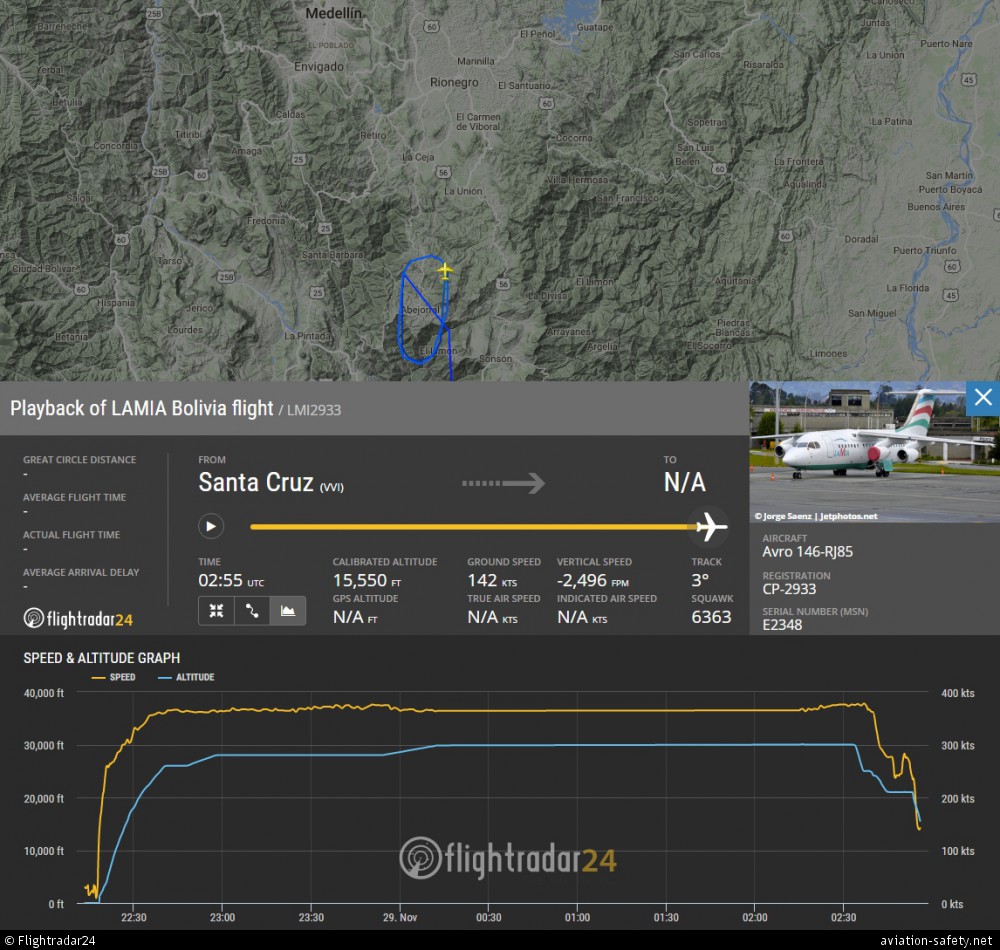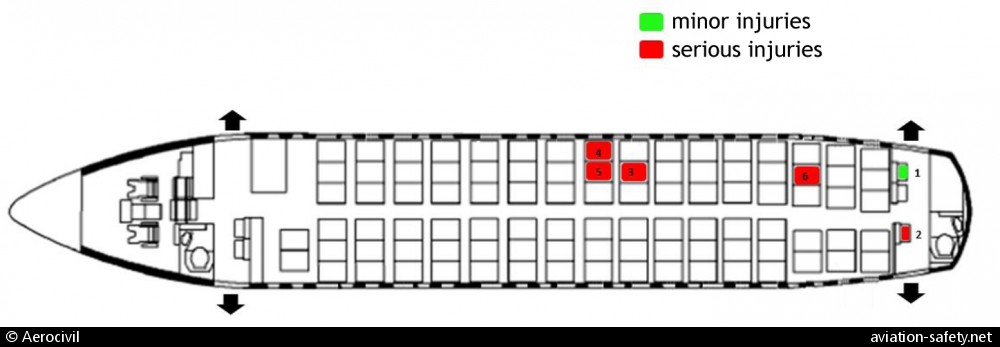
| Date: | Monday 28 November 2016 |
| Time: | 21:58 |
| Type: |  Avro RJ85 |
| Owner/operator: | LaMia |
| Registration: | CP-2933 |
| MSN: | E2348 |
| Year of manufacture: | 1999 |
| Total airframe hrs: | 21640 hours |
| Cycles: | 19737 flights |
| Engine model: | Lycoming LF507-1F |
| Fatalities: | Fatalities: 71 / Occupants: 77 |
| Aircraft damage: | Destroyed, written off |
| Category: | Accident |
| Location: | 18 km S of Rionegro/Medellín-José María Córdova Airport (MDE) -
 Colombia Colombia
|
| Phase: | En route |
| Nature: | Passenger - Non-Scheduled/charter/Air Taxi |
| Departure airport: | Santa Cruz-Viru Viru International Airport (VVI/SLVR) |
| Rionegro/Medellín-José María Córdova Airport (MDE/SKRG) | |
| Investigating agency: | Aerocivil |
| Confidence Rating: |
LaMia flight 2933, an Avro RJ85, was destroyed after impacting a wooded hillside south of Rionegro/Medellín Airport, Colombia. The aircraft carried the Brazilian Chapecoense football team for a match to Medellin.
Six of the 77 occupants have survived the accident. One flight attendant and four passengers survived with serious injuries and one passenger sustained minor injuries.
The initial plans were for LaMia to fly the Brazilian Chapecoense football team from São Paulo, Brazil to Medellin for the first leg of the 2016 Copa Sudamericana Finals against Atlético Nacional.
A refueling stop was planned at Cobija in northern Bolivia. LaMia requested a permit to fly from the Brazilian aviation authorities, ANAC, but this was denied as there were no provisions in the current aviation agreements between Brazil and Bolivia to allow such a commercial flight. The Chapecoense team was then flown to Santa Cruz in Bolivia on a regular commercial flight. This routing caused delays to the schedule and Cobija could no longer be used to refuel because of night time closure of the airport, according to the LaMia's general director.
The distance of the flight planned from Santa Cruz to Medellín was 2983 km. The flight plan of LMI2933 showed an estimated flying time of 4 hours and 22 minutes and a fuel endurance of the same time.
The flight crew calculated the takeoff weight to be 41,610 kgs, which was just below the maximum takeoff weight of 41,800 kgs. Investigators believe the luggage weight was underestimated and that the actual takeoff weight was 42,148 kgs.
At 22:08 UTC the engines of the RJ85 were started and permission was received to taxi to runway 34 for departure. Flight LMI2933 took off from runway 34 at Santa Cruz-Viru Viru Airport at 22:18 UTC.
The flight initially climbed to FL280 and later, at 23:54 UTC it climbed to FL300. En route the crew repeatedly spoke about the fuel calculations and the possibility of landing at Leticia or Bogotá to refuel, but it was decided to continue to Rionegro/Medellín. At 01:15 UTC the cockpit voice recorder (CVR) stopped recording.
At 02:36 hours, as the aircraft was descending through FL250, the Master Caution sounded in the fight deck, notifying the flight crew that they had 20 minutes worth of fuel left.
At 02:42 the Medellin Approach controller cleared the flight to continue their descent to FL210 and to head for the GEMLI RNAV point which is located about 30 km short of the runway 01 threshold at Rionegro/Medellín Airport.
At the same time, a VivaColombia Airbus A320, flight FC8170 from Bogotá to San Andrés, was diverting to Rionegro/Medellín due to indications of a fuel leak. Three other aircraft were in a holding pattern at FL190, FL180 and FL170.
At 02:45 UTC the flight reported entering the holding at GEMLI at FL210. Four minutes later the flight requested priority for landing because of "problems with the fuel". The controller then stated that she would get back with vectors to the localizer and that it would take seven minutes before they could commence their approach.
The controller then cleared a preceding flight, LAN3020, to start the approach.
At 02:52 UTC the controller reported to LMI2933 that there was another aircraft holding below them and asked if they could hold a little while longer. The flight then responded that they had a fuel emergency and requested a final approach course and immediate descent clearance. The controller cleared the flight to turn right before it could initiate descent. She subsequently cancelled the approach clearance of LAN3020.
At 02:53 selected full flaps and undercarriage down and used speed brakes in their descent. Then engine no.3 automatically shut down due to fuel exhaustion, followed by engine no.4. The flight crew did not notify the controller of this, but requested permission to immediately join the localizer. The controller assumed they were still at FL210, but the flight crew stated they were already in descent.
This forced the controller to issue instructions to the other aircraft in the holding pattern to manoeuvre them away from LMI2933. She warned the flight of another aircraft ahead at FL180. LMI2933 responded that the other traffic was on their TCAS above them and that they were on final approach course.
At 02:55 UTC engines no. 2 and no. 1 also shut down. At that time the aircraft was at 15,934 feet, 15.5 NM south of the runway 01 threshold.
At 02:57 the crew radioed in Spanish that they had suffered a "total electric total eh fault with no fuel". The controller reported that the flight was 0,1 mile from the Rionegro VOR and stated that she could not have altitude information of the flight. LMI2933 then reported being at 9000 feet.
According to the instrument approach procedure published in the SKRG AIP, the minimum altitude upon passing the Rionegro VOR is 10000 feet. During the last radio contact with the flight, the crew requested vectors for the runway. The controller stated that the flight was 8.2 miles from the runway. The aircraft impacted the top of a hillside at an elevation of about 2600 m. Part of the wreckage came to rest down the wooded hillside right next to the RNG VOR beacon, 18 km short of runway 01.
Probable causes:
Inappropriate planning and flight execution because the amount of fuel required to fly from the airport of destination to an alternate airport nor a quantity of reserve fuel nor the contingency fuel nor the minimum fuel of landing were taken into account, these fuel quantities are required by aeronautical regulations for carrying out this type of international flight like the one made by CP 2339 aircraft.
Sequential shutdown of the four (4) engines while the aircraft was in descent performing a holding pattern at GEMLI as a result of the exhaustion of fuel on board.
An inadequate decision-making process by the aircraft operating company management as a result of a lack of operational safety assurance.
Loss of situational awareness and mistaken decision- making process by the crew who insisted on continuing a flight with an extremely limited amount of fuel. The crew was aware of the low level of remaining fuel; however, the crew members did not take the corrective actions required to land at an aerodrome and refuel, fact that would allow them to continue the flight safely.
Contributing Factors:
Premature configuretion of the aircraft for landing during descent in holding pattern at GEMLI since considering the absence of thrust, this configuretion affected the plane's glide distance to Rionegro airport runway.
Latent deficiencies in the planning and execution of non-regular transportation flights by the aircraft operator related to insufficient supply of the required amount of fuel.
Specific deficiencies in the planning of the flight involved in the accident by the aircraft operator.
Lack of oversight and operational control of the flight by the Operator, it did not supervise the planning of the flight nor its execution nor it made a follow-up of the flight that would have allowed to support the crew in making decisions.
Absence of timely calls for "priority", or declaring an "emergency" or others by the aircraft crew members during the flight, and especially when fuel depletion was imminent in the descent phase and when performing a holding pattern which would have alerted air traffic services to provide the necessary support.
Organizational and operational noncompliance by the aircraft operator in the implementation of fuel management procedures, as it did not comply in practice with the approval of the Bolivian DGAC in the process of the company certification.
Delay in the approach of CP 2933 to Rionegro runway caused by its late priority request, and late emergency declaration for fuel added to heavy traffic at RNG VOR when on holding pattern.
METAR:
01:00 UTC / 20:00 local time:
SKRG 290100Z 01003KT 9999 SCT017 SCT200 17/16 A3020
02:00 UTC / 21:00 local time:
SKRG 290200Z 00000KT 9999 BKN015 SCT200 17/16 A3023
03:00 UTC / 22:00 local time:
SKRG 290300Z VRB02KT 9999 -DZ BKN015 SCT080 17/16 A3025
04:00 UTC / 23:00 local time:
SKRG 290400Z 00000KT 8000 DZ BKN015TCU SCT080 16/15 A3024 RMK RERA
Accident investigation:
 |
|
Sources:
rcnradio.com
Exame.com
ANAC Press release
Medellin ATC audio, purportedly from the accident flight
Location
Images:

photo (c) Flightradar24; near Medellín; 28 November 2016

photo (c) Aerocivil; near Medellín

photo (c) Graham; Glasgow International Airport (GLA/EGPF); 16 October 2013; (CC:by-sa)
Revision history:
| Date/time | Contributor | Updates |
|---|
The Aviation Safety Network is an exclusive service provided by:


 ©2024 Flight Safety Foundation
©2024 Flight Safety Foundation